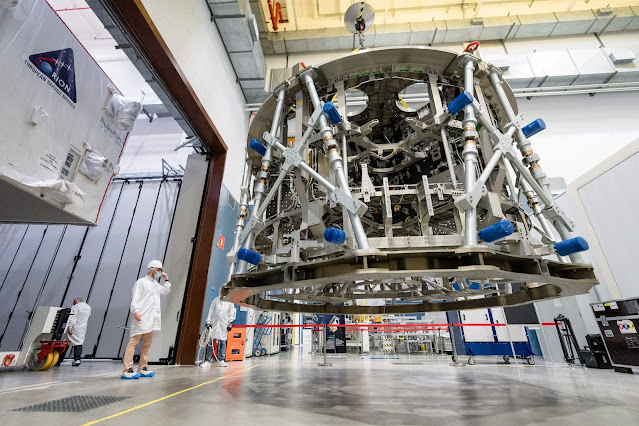NASA Artemis IV Lunar Gateway Mission: European Service Module 4
NASA's Artemis IV will be a crewed mission to the Lunar Gateway station under development. Gateway will use a Near-Rectilinear Halo Orbit (NRHO). NRHO allows a cislunar space station to save propellant for orbital corrections and it avoids the the Moon blocking sunlight to the station’s solar panels. NRHO also allows the Gateway to remain within continuous line of sight to ground controllers back on Earth and with the lunar south pole. Artemis IV will use a Space Launch System (SLS) block 1B cargo configuration. Launch is scheduled for 2026. The Block 1B configuration is capable of sending more than 81,000 pounds to deep space.
Thales Alenia Space, a joint venture between Thales (67%) and Leonardo (33%), has successfully completed activities related to the final integration of the critical systems of Orion’s European Service Module 4. The module is now on its way to Airbus Defence and Space’s clean rooms in Bremen, Germany. There, it will complete the integration and carry out final tests, supported by Thales Alenia Space engineers on-site.
NASA's Orion spacecraft will return astronauts to the Moon as part of NASA's Artemis Program. The overall European Service Module (ESM) has been developed on behalf of the European Space Agency (ESA), providing the structure, propulsion, power, thermal control, and primary life support.
In addition to ESM 4, as for previous modules 1, 2 and 3, Thales Alenia Space will provide Airbus, Orion's ESM module prime contractor, with the critical subsystems of the forthcoming ESM 5 and 6 service modules, including structure, micro-meteorite protection, thermal control, storage, and distribution of consumables. These subsystems are crucial parts of the modules as they ensure vital and safe conditions for the crew during the entire mission.
Leonardo is also a program partner, supplying the photovoltaic panels (PVA) and Power Control and Distribution Units (PCDU) for ESM modules 1 to 6.
Following component checks under Thales Alenia Space’s responsibility (including vital elements, such as the system pump and radiators) with the relevant functional checks and the final completion of the activities by the prime contractor, Airbus Defence and Space ESM 4 will then be delivered to the Kennedy Space Center in Florida, USA.
“Our company is at the heart of the industrial challenge for the return of astronauts to the Moon” said Massimo Comparini, Senior Executive Vice President Observation, Exploration and Navigation at Thales Alenia Space.
“Leveraging its long-standing technological legacy in space exploration, orbital infrastructure and space transport vehicles, Thales Alenia Space also plays a major role in this human spaceflight mission. Our goal is to provide the best solutions ever to ensure both the safety and comfort of astronauts, who will be far away from home over long-term periods.”
In addition to being responsible for the thermo-mechanical systems for the Orion European Service Module, the company is heavily involved in Lunar Gateway, providing ESPRIT and I-HAB pressurized modules to ESA. The welding of the Habitation And Logistics Outpost (HALO) is also underway at Thales Alenia Space’s plant in Turin, Italy.
Leveraging its legacy of supporting Cygnus cargo missions to the International Space Station, providing a major part of its habitable modules, Thales Alenia Space has now become a top industrial partner for the Lunar Gateway and for Axiom's commercial space station.
During the Artemis III Mission, NASA will see the first woman and the next man land on the Moon. Moreover, ESM-3 is currently in the final stages of integration and testing at Airbus Defence and Space in Bremen, Germany.
Learn more about Thales Alenia Space: www.thalesaleniaspace.com
Learn more about NASA's Artemis Program: https://www.nasa.gov/specials/artemis
Story Credit: Thales Alenia Space
Image Credit: Thales Alenia Space
#NASA #ESA #Space #Moon #Artemis #ArtemisIV #LunarGateway #Gateway #NRHO #Orion #Spacecraft #ESM #ESM4 #ThalesAlenia #Airbus #SLS #Rocket #MoonToMars #JourneyToMars #Science #Engineering #Technology #UnitedStates #Europe #Germany #Deutschland #Turin #Italy #Italia #International #HumanSpaceflight #STEM #Education




.jpg)
.jpg)
.jpg)
.jpg)
V2.jpg)
.jpg)

.jpg)
.jpg)




V1.jpg)
V2.png)
V3.jpg)
V4.png)
V5.jpg)
V6.jpg)
V7.jpg)

















